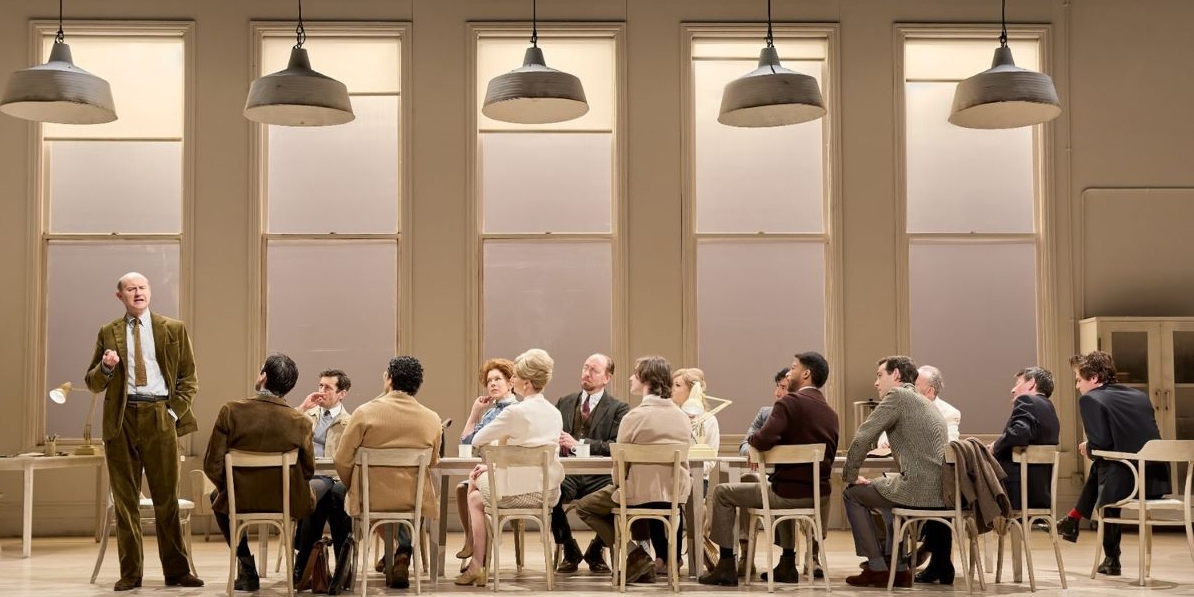This new play is both a drama and a documentary. Jack Thorne has taken rehearsal recordings and diary records of a famous production of ‘Hamlet’, and used them to create a meditation upon different styles of acting and indeed the whole question of what distinguishes great acting from the merely mediocre. These issues are rendered more immediate and compelling by channeling them through the characters of John Gielgud, Richard Burton and Elizabeth Taylor so that it all comes to us wrapped in a fable of theatre royalty.
In 1964 Richard Burton and Elizabeth Taylor were at the very height of their box-office celebrity, when Burton returned to the stage on Broadway in a new production directed by Sir John Gielgud, then aged sixty. Gielgud had made the role of Hamlet his own in the inter-war years, but now with his career in the doldrums, and in the wake of social and legal humiliations, this was a chance to pass on his insights and once again have his say. Except it did not work out like that. The styles and approaches of the actors clashed: Burton found Gielgud too changeable and mercurial and focused on minute readings of the text; while Gielgud found Burton’s repeated drunkenness simply unprofessional and his reading of the role lazy and superficial. For the other actors in the rehearsal room it seemed as though both egos were too big, leaving little time for them.
What makes this play work above all is the witty quality of the dialogue and the fascinating jousting between the three lead actors, all of whom deliver stylish and highly credible performances. Rightly, everyone avoids direct physical and vocal mimicry of the famous attributes and mannerisms of Burton, Gielgud and Taylor. Johnny Flynn, Mark Gatiss, and Tuppence Middleton nevertheless give very plausible accounts of the characters of each. Flynn captures Burton’s boisterous bonhomie hiding inner insecurity, and also gives a credible account of what a bullying, cruel person he could be when drunk. Gatiss is all gossamer finesse and arch whimsy to start with, but later reveals a core of tempered steel and resilience that he has developed to face up to ‘slings and arrows of outrageous fortune. The very end of the first act when he delivers Gielgud’s version of Hamlet’s address to the Players is an outstanding high point, the epitome of traditional textual Shakespeare, and a distillation of the virtues of that approach. Middleton offers a much more layered approach to Taylor’s glamour than is usual, portraying her as much more deeply interested in the art of acting than is usually supposed and a conciliatory figure between her husband and Gielgud. We learn more about her through seeing her off to one side than we normally do from front and centre.
What is perhaps less successful is what is left for the rest of the cast. Much of the action takes place in the rehearsal room, but there is not so much for any of the many players to do whether in character in ‘Hamlet’, or as themselves. There are some good moments for Janie Dee as Gertrude, delivering her eulogy for Ophelia, and Allan Corduner is given good lines whether as Polonius or as Hugh Cronyn, the actor who played him. Luke Norris gets a chance to offer the younger actor’s perspective through his portrayal of William Sterne, who later in life wrote up his memories of this production extensively. But for the most part everyone else is essentially part of the decorative framework within which the leading trio debate. Given the nature of the play it is perhaps inevitable, but it does seem something of a waste.
Director Sam Mendes and designer Es Devlin present a series of stylish but simple sets. The essential contrast is between the cream and beige and magnolia ordinariness of a rehearsal space and the garish luxury of the Taylor-Burton apartment. Appropriately, when the focus is on the text the visual frame narrows – at the very end we are simply on an empty stage ahead of the first night as the lead figures confront final home truths. There is always the danger in this sort of play about the theatre itself that it remains of interest only to theatre afficianados. This is emphatically not the case here, where deep issues and aesthetic disagreements are there to be found, but only within and alongside a continually diverting and absorbing narrative line.

